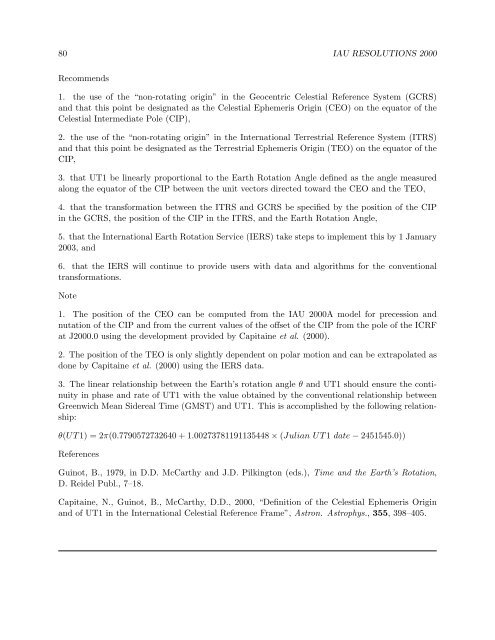USNO Circular 179 - U.S. Naval Observatory
USNO Circular 179 - U.S. Naval Observatory
USNO Circular 179 - U.S. Naval Observatory
Create successful ePaper yourself
Turn your PDF publications into a flip-book with our unique Google optimized e-Paper software.
80 IAU RESOLUTIONS 2000<br />
Recommends<br />
1. the use of the “non-rotating origin” in the Geocentric Celestial Reference System (GCRS)<br />
and that this point be designated as the Celestial Ephemeris Origin (CEO) on the equator of the<br />
Celestial Intermediate Pole (CIP),<br />
2. the use of the “non-rotating origin” in the International Terrestrial Reference System (ITRS)<br />
and that this point be designated as the Terrestrial Ephemeris Origin (TEO) on the equator of the<br />
CIP,<br />
3. that UT1 be linearly proportional to the Earth Rotation Angle defined as the angle measured<br />
along the equator of the CIP between the unit vectors directed toward the CEO and the TEO,<br />
4. that the transformation between the ITRS and GCRS be specified by the position of the CIP<br />
in the GCRS, the position of the CIP in the ITRS, and the Earth Rotation Angle,<br />
5. that the International Earth Rotation Service (IERS) take steps to implement this by 1 January<br />
2003, and<br />
6. that the IERS will continue to provide users with data and algorithms for the conventional<br />
transformations.<br />
Note<br />
1. The position of the CEO can be computed from the IAU 2000A model for precession and<br />
nutation of the CIP and from the current values of the offset of the CIP from the pole of the ICRF<br />
at J2000.0 using the development provided by Capitaine et al. (2000).<br />
2. The position of the TEO is only slightly dependent on polar motion and can be extrapolated as<br />
done by Capitaine et al. (2000) using the IERS data.<br />
3. The linear relationship between the Earth’s rotation angle θ and UT1 should ensure the continuity<br />
in phase and rate of UT1 with the value obtained by the conventional relationship between<br />
Greenwich Mean Sidereal Time (GMST) and UT1. This is accomplished by the following relationship:<br />
θ(UT 1) = 2π(0.7790572732640 + 1.00273781191135448 × (Julian UT 1 date − 2451545.0))<br />
References<br />
Guinot, B., 1979, in D.D. McCarthy and J.D. Pilkington (eds.), Time and the Earth’s Rotation,<br />
D. Reidel Publ., 7–18.<br />
Capitaine, N., Guinot, B., McCarthy, D.D., 2000, “Definition of the Celestial Ephemeris Origin<br />
and of UT1 in the International Celestial Reference Frame”, Astron. Astrophys., 355, 398–405.


